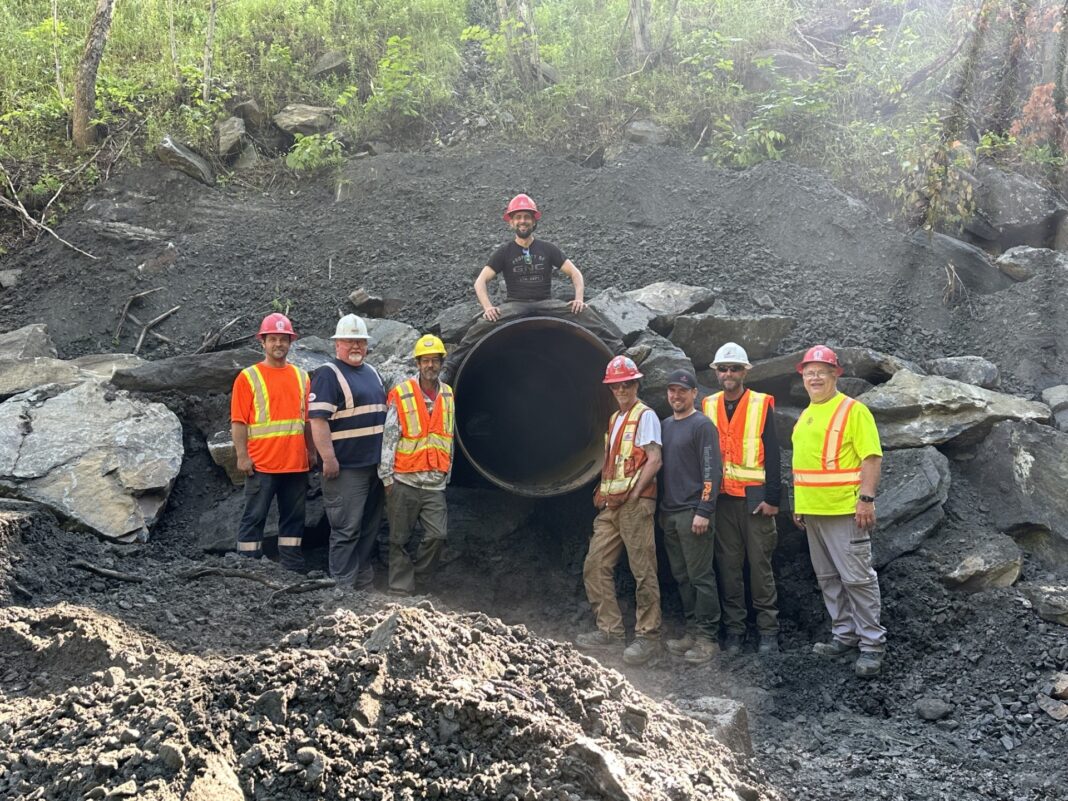A Haliburton County-based contractor has taken part in a pilot project that could now be used across the province.
The work involved a culvert replacement 1.3 kilometres north of Hwy. 35 on Hwy. 118.
The Ministry of Transportation (MTO) hired Braithwaite Drilling Services for the roadworks and they were assisted by Francis Thomas Contracting (FTC) of Carnarvon.
Britt Thomas of FTC said, “it’s been cool to be a part of this, and it is a historic thing for both Carnarvon and our company.”
Matt Braithwaite, of Braithwaite Drilling Services, Peterborough, said they used equipment that has been employed in Europe, but is new to the province. Rather than having to dig up the highway above the culvert, they were able to bore through the side. Braithwaite said it is faster and cheaper.
“We used the Geonex (drill) to hammer in a 40-inch culvert through blast rock. We were able to avoid any auguring techniques – where you wouldn’t be able to do that in blast rock because it would fall in and you couldn’t hold the hole open.”
He said the special drill allows the casing to go in with the hammer. “You only have three quarters of an inch of open space at any given time while you’re drilling, and when you’re done, the casing becomes the product pipe. And in this case, it was a culvert.”
He noted the drill is worth about $2-3 million.
“It’s been used in Europe for the last 15 or so years, and certain parts of the United States where it’s applicable, like right now in New York, there’s numerous projects going on.” He said the technology has been used in western Canada, too.
“But Ontario’s never had one, so we’re a little bit behind, but we’re getting there. So, it was a pilot for Ontario, but not necessarily the technology itself.”
Braithwaite said his company had been working with the MTO for the past seven years on culvert replacements. He said there had been a bit of trial and error with other methods.
He said there is no doubt using the Geonex saved time and money, “because we learned after the fact that a temporary bridge would have had to have been created and installed in order to do that because of the volume of traffic on the road. So, we’re talking like 10 and 20-50 times the savings.”
An MTO spokesperson confirmed the pilot project was initiated to try out trenchless culvert installations in deep rock fills. She said the trial site consisted of a 12-metrehigh rock fill, and consisted of the trenchless installation of a culvert with a diameter of 1.2 metres and a length of 40 metres.
“Following the success of this pilot project, trenchless installation can now be considered as a culvert replacement option in rock fills,” she added. “The ministry will look for future suitable locations to utilize this specialized technology in an effort to reduce construction costs and impacts to the travelling public.”
Braithwaite said they could not have done it without FTC.
“They were fantastic. They brought in all the excavation and earth-moving equipment for us. They constructed a temporary road that allowed us to bring our equipment down. They provided all the support during the drilling, so all of the cuttings that were brought out of the hole, they were able to remove, either bringing them to their pit or just remove them on-site. And then they helped us load and unload, mobilize, demobilize, just provided fantastic support through the whole project.”
Braithwaite added, “it is exciting, and I know it’s exciting for the people up there to be part of.”
Thomas added it was a proud moment for the local company. “We’ve never been a part of anything of that sort before, so it’s been a learning experience in so many ways.”





